LED Football Sports Field/Stadium Lights Manufacturer and Supplier in China
RC Lighting is an outdoor LED football sports field/stadium lights manufacturer and supplier in China. We are dedicated to supplying high-quality lighting products CONTINUOUSLY, which makes us enjoy a high reputation and go into more markets.
- Timely Delivery.
- Competitive price.
- Five-year warranty.
Outdoor LED Football Field Lights
Browse our Football Field Lights collection for affordable LED Football Field Lights that can easily illuminate the entire field. Ask for a quote now!
100W LED Football Field Lights
200W LED Football Field Lights
300W LED Football Field Lights
400W LED Football Field Lights
500W LED Football Field Lights
600W LED Football Field Lights
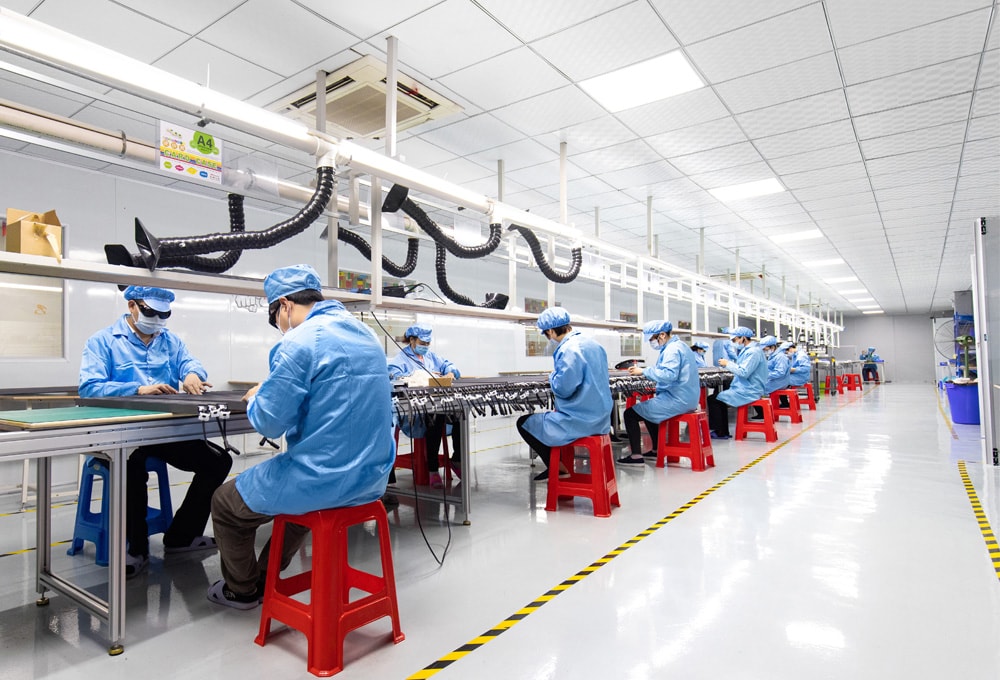
Leading LED Football Sports Field/Stadium Lights Manufacturer
RC Lighting committed to providing quality LED football sports field light products that meet all your needs.
- Professional Craftsmanship
- Customization Capability
- ISO9001, UL/ETL, CE
- 5 Year Warranty
LED Football Field Lights FAQ
Football field and stadium lights are all customized, heavy-duty floodlights. Floodlights have a wide beam angle (up to 120°) and can illuminate a whole area effortlessly. Note that floodlights are different from spotlights that are used to light up a specific spot.
As the gameplay level increases, the wattage requirement increases. Moreover, watts depend on the area of the football field. Usually, 200 lux is required for a recreational/training football court of 105 x 60 meters. So, the power required is calculated as follows:
105 x 60 x 200 / 150(W per lumen) = 8400 Watts.
According to international standards, football lighting is divided into seven levels.
- Recreation/training/beginner’s level: Indoor (300lx), Outdoor (200lx)
- Amateur Level: Indoor (500lx), Outdoor (300lx)
- Professional Level: Indoor (750lx), Outdoor (500lx)
- TV broadcast: Indoor (1000lx), Outdoor (1000lx)
- International TV broadcasting: Indoor (1400lx), Outdoor (1400lx)
- TV Emergency: Indoor (750lx), Outdoor (1000lx)
You can alter these rules according to your needs and preferences.
LED football field lights take a few seconds to turn on and reach 100% output. If you are using sensors and controls, you can easily adjust the on/off timing and use the dimming option to dim the not-in-use lights. Using solar football lights can save the amount of power and energy.
Football stadium lights can be as high as 70ft and can even reach a height of ~250 ft for bigger stadiums and international games. The beam angles are adjusted according to the height of the fixtures.
Metal halides take 5-20 mins to reach the optimum lighting output. The salts inside have to vaporize and produce tremendous heat to light up, hence the warm-up time. This heat can ignite a fire and can cause the lamps to explode.
LEDs are a safe alternative to metal halides/HIDs. They take no more than a few seconds to reach the brightest output and have efficient heat sinks.
As the football game level increases, the electricity cost will increase. This is because higher watts and lumens are required for the professional level.
If we take the high school football field example, it requires ~300 lm and 35000 W LED. The monthly calculation will go as follows:
35000 x $0.12/1000 x 8 hrs x 30 days = $1008.
The monthly expenditure will be ten times less than the cost of electricity in the case of halogen bulbs.
LED football field lights' wattage can range from 100 Watts to 5000 Watts, and the lumens can go as high as 750,000 lm. The watts depend on the level of the football game. Smaller wattage bulbs work best from small-level games such as high school, beginner-level gameplays.
However, for high-level tournaments, up to 5000 watts are used to fulfill the lumen needs.
Get Started With RC Lighting Today!
Send us an inquiry for your requirements, and we will get back to you shortly.
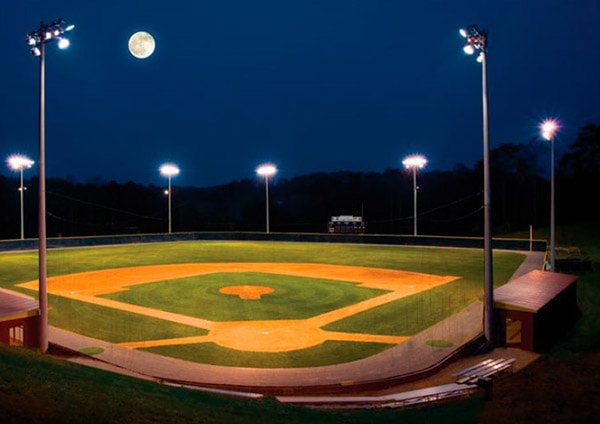
How to Buy LED Baseball Field Lights – A Complete Buyer’s Guide
Lighting a baseball field, like any large lighting project, is a massive undertaking. Depending on the location of the field, its size, and whether it is meant for Little League or Major League play, each field has its own set of standards. Because baseball involves a tiny object traveling at high speed, the LED Baseball field lights must be far more intense than, say, lighting for a soccer pitch.
Table of Contents
What Are LED Baseball Field Lights?
LED baseball field lights are fixtures used for baseball/softball field lighting. They can brighten up an entire field while distributing light evenly. Baseball is one of the most popular and widely played sports in the world. A baseball diamond, often known as a sandlot, is a field where baseball is played. Regardless of the level of play, baseball field lighting must ensure that every region of the field is evenly lit and that no light fixtures interfere with the game’s play.
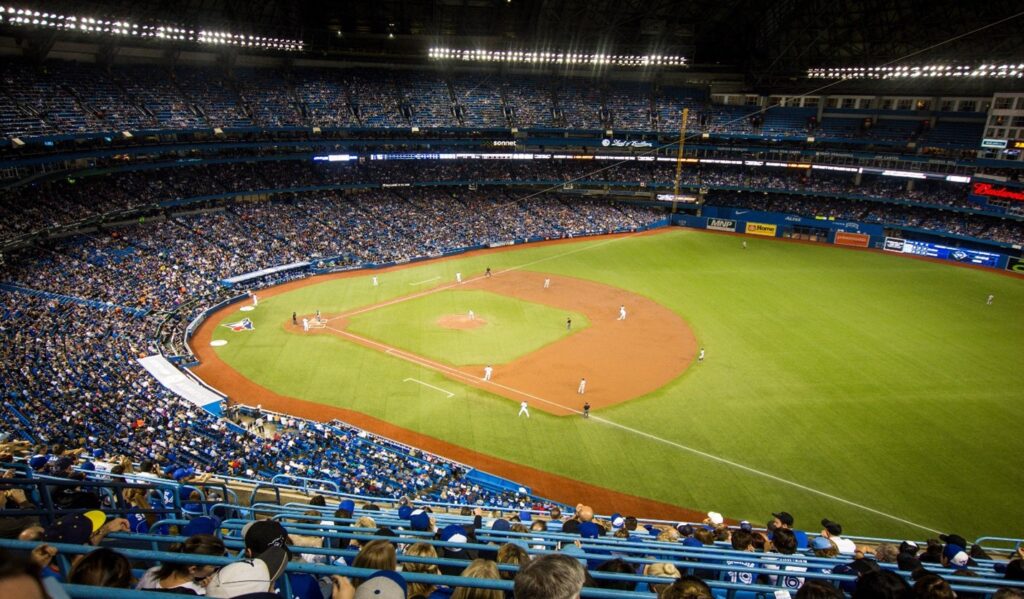
Furthermore, LED lights are cost-effective, saving up to 80% of energy. LED lights have a low to nil maintenance cost. This is because LED lights have a longer life span. Here we are, with everything you need to know about LED baseball field lights.
What Are The Benefits Of LED Baseball Field Lights?
Lighting is one of the most critical components of a baseball field. LED baseball field lights, without a doubt, play an essential role in gameplay. For both players and spectators, this style of illumination improves visibility. In addition, it has a direct impact on the players’ performance. Following are the benefits of using these lights.
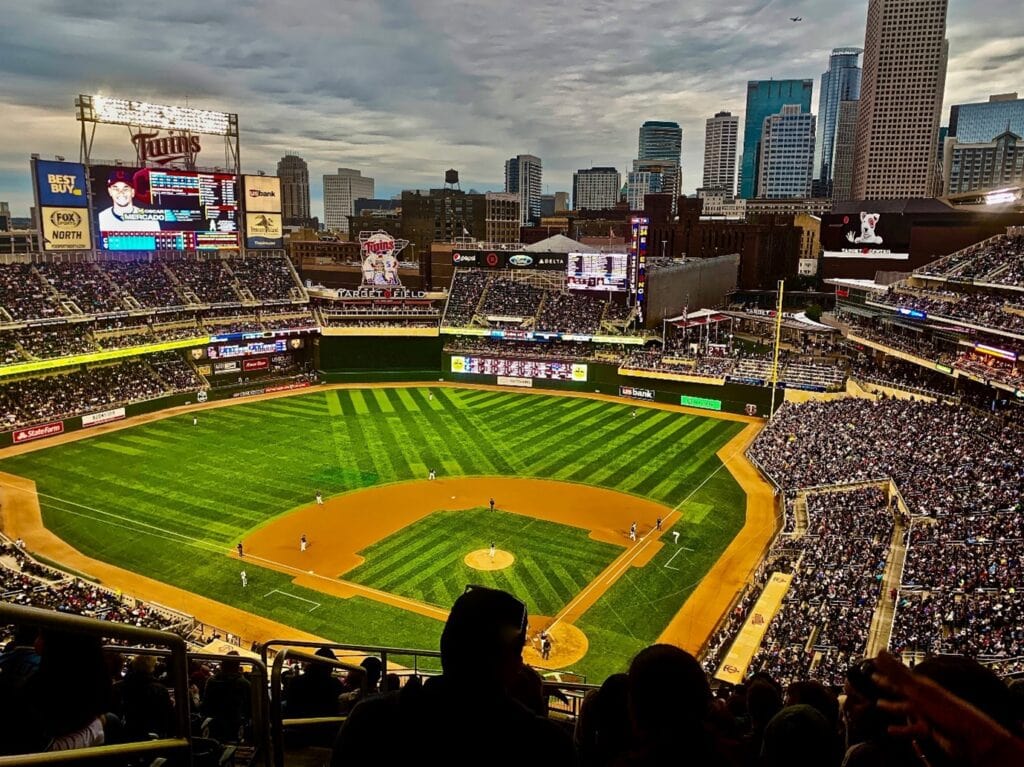
Environment-Friendly LED Baseball Field Lights
LED lights do not emit UV rays, and only around 5% of the electricity they generate is converted to heat. This means they don’t produce a lot of heat and, as such, are organic and green-friendly. Nowadays, another environmentally safe factor is the inclusion of heat sinks in LED light fixtures. These sinks prevent overheating and allow the lights to survive a wide range of temperatures and weather conditions.
Better For Broadcasting
Broadcasting in LED lighting for baseball stadiums is heaps better than using the alternative metal halide lights. LED lights turn on quicker, are adjustable, etc., required during filming, whereas the metal halide lights are much slower to even reach maximum brightness!
Televised games are often recorded live in high quality, and since LED lights have minute flickering, slow-motion replays are much easier to broadcast.
Energy Savings By LED Lights
LED baseball field lights to make sure that they don’t cost you a large amount of money and save you about 70% of energy.
Longer Life Expectancy
They have longer life spans of approximately 10-40 years.
Improved Illumination On The Baseball Field
LED stadium lights provide the audience with the best view from every side of the stadium, and also players can play without any difficulty.
Horizontal And Vertical Illumination
Because the baseball is minor, moves quickly, and changes in trajectory are challenging to catch, sufficient horizontal and vertical illumination over a specified height range is required.
Compatibility With The Gradient Connection
It is compatible with the uniformity and gradient connection to meet the lighting
No Light Pollution, High Uniformity
Uneven field brightness will influence the line of sight, affecting both the player’s performance and the audience’s enjoyment. Therefore, LED baseball field lights are fitted with Secondary Optical Aluminum reflective cups and lenses for the best results and to eliminate light pollution.
The high-quality products come with a 10-year parts warranty and a 28-year lifespan with an average runtime of 8 hours per day. Their durability promises that maintenance won’t be a problem for a long time. To light a regular baseball field, the total cost ranges from $120,000 to $200,000 if purchased in the United States or Europe, yet it is just $40,000 to $90,000 in China.
Why Do You Need To Upgrade Lights To LED Baseball Field Lights?
Life Expectancy
LED lights have an average life expectancy of 80,000 hours; hence they can run for a long time. This proves advantageous since it decreases maintenance costs in the long run. However, metal halide lamps are also significantly less safe for people and the environment than LED lights.
Power Ranges
Metal halide lights have an average power ranging from 400 to 1500 watts, with 1500-watt lights being used on most baseball fields due to the need for high-intensity lighting. Still, metal halides have a slow turn-on time of about 30 minutes to reach maximum brightness. Metal halide lights also become extremely hot and require a long time to return to normal temperature. LED baseball field lights come in various ranges, ranging from 100 watts to 600 watts.
Time Saving Ability
If the electricity to a metal halide light is ever unplugged, it will immediately shut down and take anywhere from five to ten minutes to resume.
The LED Stadium Lighting Era Has Begun
One disadvantage of metal halide lighting is that as the lamps age, their color begins to shift. Individual lights will start to change at different periods, resulting in a slightly different appearance over time. Unfortunately, a small amount of mercury is vital to many metal halide lights. Thus, it makes them harmful to the environment.
Pollution Free Environment
Finally, metal halide lights emit ultraviolet radiation, which can cause disease if inhaled. While many stadiums still utilize metal halide lights, contractors are beginning to move to 500-watt LED lights to replace 1500-watt metal halide lighting.
The explanation for the change is simple calculations. A halogen-based 500-watt baseball stadium light will cost you around $40, while a 500-watt LED baseball field light would set you back around $400. The reason for this is that halogen lumens are ten times lower than LED lumens. What does this mean? It means that ten times more halogen lights will be required to match the intensity of LED lights.
How To Choose LED Baseball Field Lights?
LED baseball field lights are heavy-duty fixtures that must fulfill specific requirements such as strength, durability, beam angles, lumens, flicker-free, weather-proof characteristics, and much more. So let’s have a look at these points.
Anti-Glare
Glare can easily disrupt the whole game by disturbing the view of the players and causing confusion during the gameplay. Baseball itself is a small object which is the field must be optimally lit.
Glare depends on the position of the light. The fixture must throw light directly down to the field. A slight miscalculation in angles and placement can cause a problem. Moreover, diffusers are installed in the LEDs to reduce glare.
Color temperature and CRI
According to baseball lighting standards, the minimum color temperature of 5700K is preferred for pro-baseball and international games. Daylight is mimicked for such high-level gameplays. A CRI of 65+ is acceptable for baseball field lighting. The higher CRI, the better.
For broadcasting purposes, a better measure is TLCI which gives a more quality rating. TLCI (Television Lighting Consistency Index) of 90+ is best for broadcasted matches.
Level | Color temperature preferred |
Recreational/training | 3000K |
High school/college | 5000K |
Professional televised games | 6000K |
Beam Angles
Beam angles are deemed crucial in stadium lighting. Therefore, a general rule is higher the pole, the smaller the beam angle, and vice versa.
For long-range baseball field lights, 15-45° is optimum, whereas, for short-range infield lights, 60-90° is preferred.
Brightness and Lumens
The brightness varies with multiple variables, the area of the field being an essential variable. For example, the infield requires a higher illumination level than the outfield as all the action takes place inside where a referee is standing.
The major league baseball field is larger and requires 1500lx in infield and 1000lx in the outfield. Whereas for regular minor fields, the infield light should be a minimum of 538lx, and the outfield light should be 322lx.
The table below shows the standards set for every level of the field. These are not hard and fast rules and can be altered as per preferences and on-site variables.
Field Level | Infield(lx) | Outfield(lx) |
Recreational | 300 | 200 |
Amateur | 500 | 300 |
General | 1000 | 700 |
Professional | 1500 | 1000 |
The lighting level in footcandles according to standards:
Type | Target Light Levels | Max/min Uniformity Ratio |
Baseball/softball field | 50 fc (Infield) 30 fc (Outfield) | 2:1 (Infield) 2.5:1 (Outfield) |
Light Uniformity
Lighting uniformity means how uniforms and homogenous the illumination is in the field. To measure this, the field area and the lux rate is calculated. Lux number increases where the light spread overlaps. For fields with higher lux levels (international games), the light uniformity ranges between 0.6 and 0.7. For high school and smaller leagues, 0.5 to 0.6 is best suited. For smaller training fields, the number is rated at 0.4 to 0.6.
Flicker-free
When a game is being broadcasted, there is a high chance of the camera not capturing the shots played. Therefore, 4K high cameras must be used, and the lighting should be flicker-free to capture a smooth play.
Flicker is usually a problem in metal halides, and ballast controls reduce the flicker rate in these lamps. However, in LEDs, flickering is already very low due to high flash pulses.
Wattage
Baseball and softball field lights’ wattage are mainly 400W, 1000W, 1500W, and 2000W. As the field area and gameplay level increase, higher wattage lamps are used.
Number of Fixtures Required
The number of lighting poles depends on the field area and level of play. There are mainly 4, 6, and 8 pole setups, as shown in the figure. A minimum of 2 poles are allotted for the infield, and 4/6 poles are placed across the outfield.
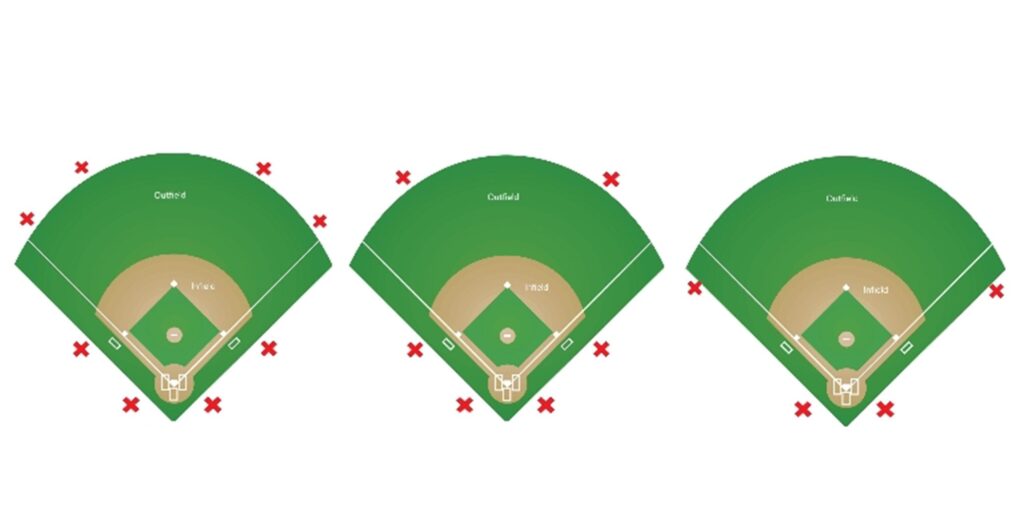
A 4-pole setup is best for smaller fields with a ballfield radius close to 200-250 feet. Any field larger than that will require a 6 or 8 pole setup. The major league always uses eight pole layout.
Fixture Poles Placement
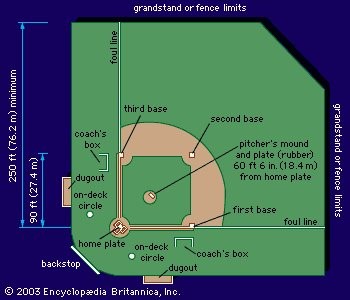
The lighting follows a strict placement design. This is the job of a lighting engineer as he designs the placement according to the field characteristics. The poles are placed at the perimeter of the outfield.
- Two poles illuminate the infield. These are placed behind the home plate.
- The third and fourth poles are estimated 140-170 feet distance from the origin of the field radius.
- In the 6 and 8-pole layout, the rest of the poles are placed at the parameters of the outfield, as shown in the figure below.
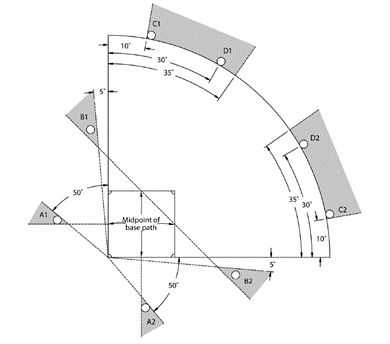
Pole Height
The lighting poles eight vary with the field area and level of play. However, a general standard for each field is explained below:
- For recreational fields and little league baseball games, a height of 12-15 meters is usually preferred. Such applications don’t require a very high-standard lighting design. The height mentioned is cost-effective and is optimal for casual games.
- For high school and college games, the height increases to 15-40 meters.
- For televised international games such as MLB National, the highest standards are implemented, and 25-60 meter height is preferred.
Material and IP-Rating
Since field lighting fixtures face all kinds of weather changes and corrosive pollutants in the environment, they must be made with high-strength materials such as galvanized steel, stainless steel, and aluminum. In addition, wiring must be enveloped in conduits and covers.
All components must be UL-listed and meet NFPA 780 standards for safe functioning.
LED baseball lights must have a rating of IP67 or IP68.
Lighting Control and Sensors
It is a desirable feature and can save a lot of power and money in the long run. Moreover, owners can schedule the on/off timing of these lights fixtures hence saving electricity efficiently.
Cost of Electricity
LEDs can easily save you about 70% of electricity compared to traditional halogen or halide lamps. Here’s a rough calculation.
If you want to light up a baseball field using a 30,000 W bulb, the daily cost will be; 30,000×0.12/1000x 8hrs= $28.8. This amounts to $864 monthly.
On the other hand, for equivalent light output, in the case of a halogen bulb, you need a 300,000 W lamp; 300,000×0.12/1000×8= $288. So monthly charges will roughly amount to a whopping $8640!
You can now decide what is best for your baseball field.
Conclusion
As a result, baseball field illumination plays a critical role in player performance and safety. This is why it needs to be meticulously prepared. A proper lighting design must take into account the LED baseball field lights’ full capability. Therefore, we provide you with the best of the lot based on all known details and professional acknowledgment, such as brightness levels, uniformity standards, pole location, and height, led sports lights selection, and, most importantly, the most cost-effective option.
RC Lighting is here to assist you if you still have an issue. Our team of lighting professionals is always available to assist you in adequately designing, purchasing, and installing lights
Send Your Inquiry Now
How to Buy LED Football Field Lights – A Complete Buyer’s Guide
Many people are fascinated by the lighting used in football stadiums. But, what kind of lighting should be used in a football stadium or other sporting venue? Football stadium lighting has its own set of standards that must be adhered to while installing lights in the ground.
Table of Contents
The following content will teach you everything you need to know about choosing the best LED football field lights.
What Are LED Football Field Lights?
LED football field lights are the sturdy lighting fixtures installed at a height to light up the stadium enough so that you can have a fantastic match view within your budget. They are installed at 70ft height for regular games, whereas the height can reach up to 250 ft above the ground for professional televised games.
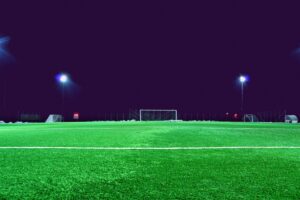
LED football field lights and basketball court lights are becoming more popular at all levels of play in the world of stadium lights. Players, coaches, fans, broadcasters, and journalists will benefit from the improved visibility provided by these lights.
LED lighting delivers high-quality, anti-glare, brilliant lighting. In addition, if you value safety and environmental friendliness, LED lighting is the way to go, as it emits no hazardous ultraviolet or infrared emissions and contains no mercury.
The actual sizes of lighting fixtures in the fields differ depending on the field’s size. Therefore, the fundamental physics of stadium lights can be a huge concern, and you need to understand what’s going on if you want to light your stadium or field properly.
Let’s look at the benefits of stadium lights stadium-lights and how they can help players and fans alike have the most satisfactory sporting experience possible.
Why Choose LED Football Field Lights?
With the growth of technology, the requirements have gotten much higher, including using the most up-to-date technologies, such as LED lighting, to illuminate the venues. Every second of action matters on the football field, and having the proper lighting is crucial for top performance. Let’s look at the benefits of stadium lights and how they can help players and fans alike have the most satisfactory sporting experience possible.
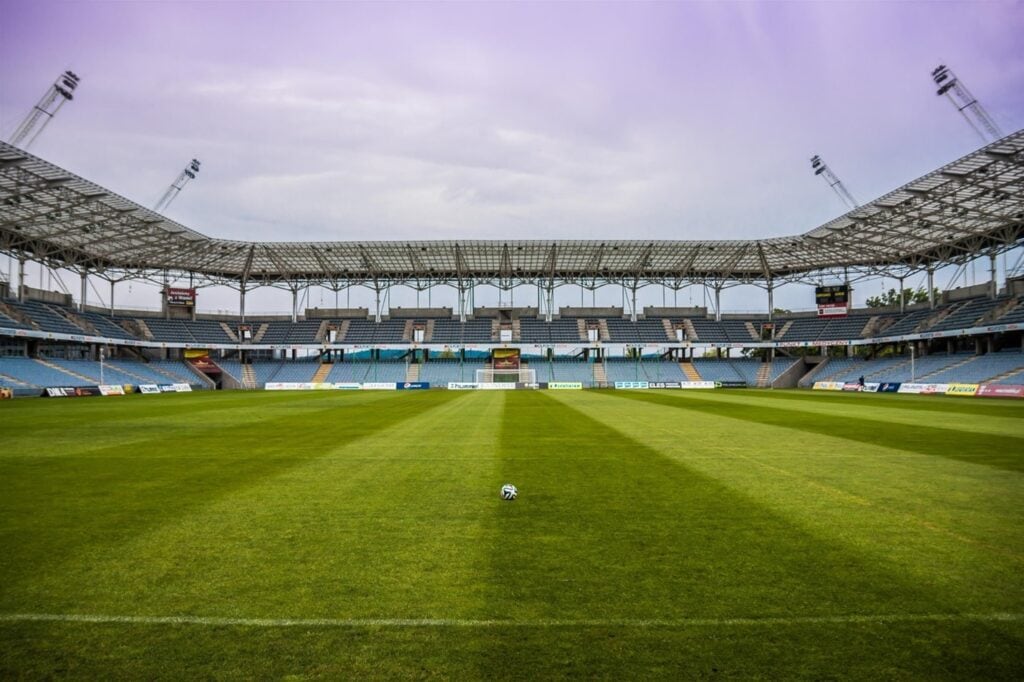
Appropriate for Presentation and Broadcast
If your stadium is located near a local news station, they will be drawn to the events there because LED football field lights are easy to televise. In addition, their broadcast will appear more professional because of the LED light’s clean, clear quality. They are even available in 15D, 20D, 30D, 45D, and 60D for maximum uniformity.
The intensity of LED lights makes capturing the contrast of events more straightforward for television cameras or digital devices. This means the ball will stand out more, the players will appear more defined, and the supporters will no longer appear to be a faceless blob.
You will attract individuals who want to conduct such events to your stadium if you have a high-quality LED lighting system.
Because LED lights are directed, they provide excellent clarity. However, they do not project light 360 degrees around the bulb, as do conventional lights, necessitating the use of reflectors. In LEDs, any reflecting surface only enhances the light by catching the tiny beams around the diode.
Led football field lights are available in various power ranges like 300W, 500W, and up to 2000W, depending on the requirements.
They Don’t Produce heat.
LEDs don’t produce a lot of heat. So you can touch an LED with your bare hand while it’s still on. This makes them safer to deal with, but it also helps maintain the quality of the fixtures in which they are installed.
A sound lighting system, on the other hand, comes with sufficient ventilation. So, when you’re looking for lighting for the stadium, try to get ones that are built entirely of aluminum. Because aluminum has the best conductivity, it will prevent your LED lights from overheating.
You Have Control Over Lighting
When it comes to lighting a football match, LED football field lights provide you with more control over the quantity of light produced. You can also change the hue of the light in some systems.
You may adjust your light reactions to the game by using programmable light systems. This can be used to generate excitement, recognize your team, or even frighten your opponents. For example, fans will be ecstatic if the lights flash your team’s color during a touchdown.
Because you will be in charge of where and how the lights glare, the spectators at your stadium will appreciate not having the glare of lights mar their view.
You can also set up a system that gradually increases the brightness as the daylight decreases. This helps to keep the system’s energy consumption and operational costs under control. Led floodlights are also used to light up the stadium.
You can use it in a variety of ways.
Led-stadium lights are a terrific method to expand your stadium’s capabilities. If you want to hold concerts, LED football field lights are powerful and precise enough; no additional lighting is required.
Increasing the number of times your stadium is used can help you earn more money. The more revenue your stadium can create, the more successful it will be. In addition, providing a venue for a range of activities in your neighborhood increases the stadium’s value to the people who live nearby.
Why Are LED Football Field Lights A Better Option Than Metal Halide Lights?
LED lights, compared to Metal Halide Lights and High-Pressure Sodium Lights, can provide an incredible experience. But are you aware of the reasons for the distinction between LED and Metal Halide lights? We’ll give you an accurate response.
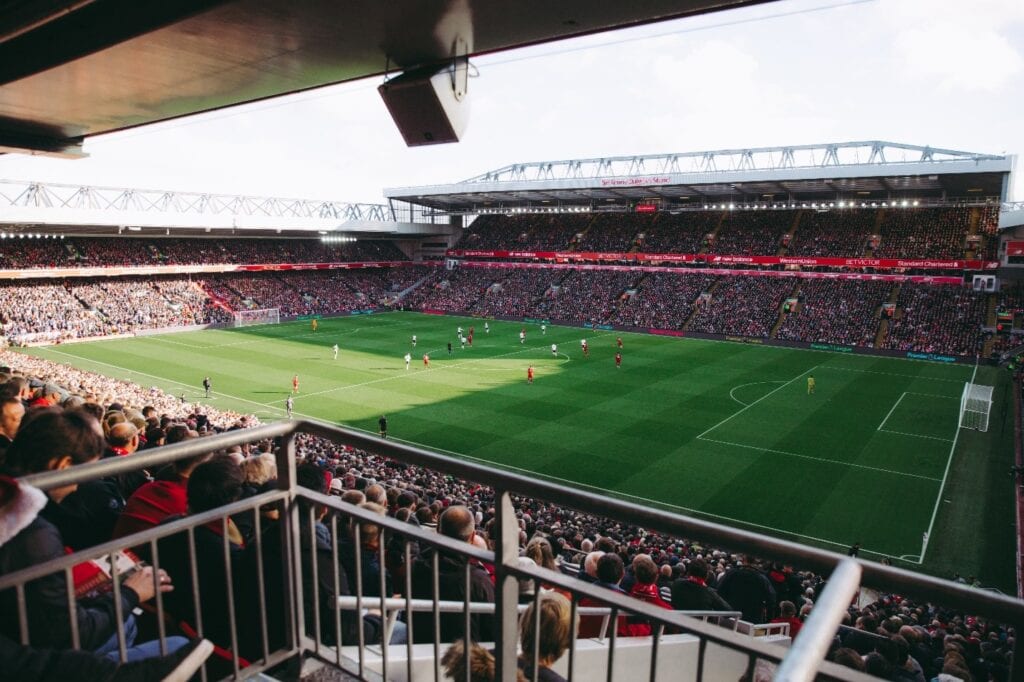
Energy Costs
LED lights produce more lumens at a lesser cost. For example, a 400-watt metal halide light can produce approximately 20,500 lumens. A 150-watt LED light, on the other hand, can produce 22,500 lumens. As a result, switching to LED outdoor stadium lights instead of metal halide lights can save you up to 70% on energy costs.
The best thing is that LED stadium lights outperform Metal Halide lights in terms of luminosity. As a result, LED stadium lights provide a superb lighting experience for a long time without increasing your energy expenditures.
When it comes to maintenance costs, it appears that LED stadium lights are more efficient. However, metal halide lamps have a fast rate of lumen depreciation as well as a limited lifespan. As a result, you’d have to replace the lights regularly.
Durability
LED football field lights can live up to 25 times longer than regular bulbs and can function up to 80000 hrs. This not only saves you money on new lights, but it also saves you time changing the lighting.
Changing the lights at many stadiums may be complex and risky. It necessitates the employment of safety equipment and, in some situations, the presence of a bucket truck on the job site. This can lead to field damage, which will necessitate even more labor to fix.
While upgrading to an LED system may appear costly, you will avoid the hassle of changing light bulbs frequently.
On the other hand, blown lights can frighten youngsters, cause delays, and limit the visibility of spectators and players. If any of these things occur, your stadium will not function as effectively as possible if LED lighting had been employed.
How To Choose Best Football Field Lights?
When it comes to the ambiance of a football field, lighting is a game-changer. LED football field lights are the stadium lights that have recently taken the place of classic high-pressure sodium or metal halide stadium lights.
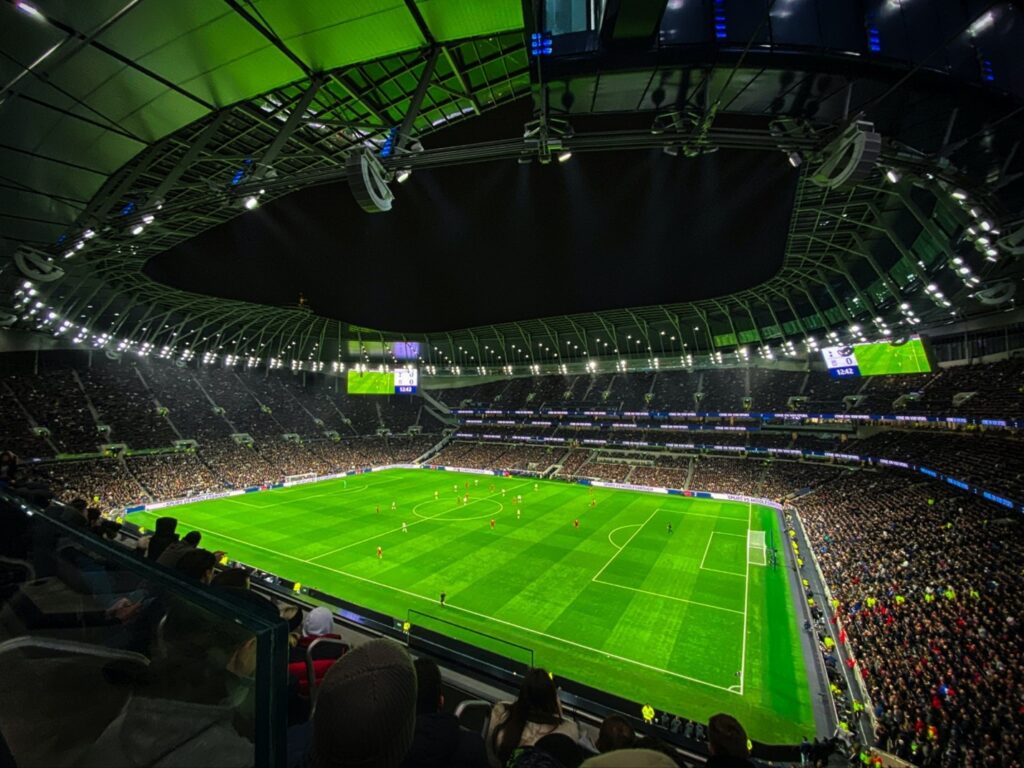
LED football field lights produce a uniformly lit stadium, giving spectators and athletes a better view of the activity on the field. Better illumination means better athletic competitiveness and, as a result, a higher level of entertainment for patrons. In addition, they have a longer lifespan because they are low maintenance and require minor repair over time.
Color temperature and CRI
Football field usually requires a color temperature range of 5000-5600K for high and adequate brightness.
For stadium lights such as football field lights, higher CRI values are preferred. For example, 80 Ra is used for regular, recreational, and semi-professional matches, whereas 90+ Ra is used for TV broadcasting.
Brightness and Lumens
Brightness mainly depends on the application level of the football field. The following table will give you a rough idea of the illumination requirements:
Recreational Matches | 200 lux | 360,0000lm |
Amateur Competition | 500 lux | 420,0000lm |
Professional competition | 750 lux | 600,0000lm |
TV broadcast | 1000 lux | 126,000,00lm |
International competition broadcast | 1400 lux | 309,000,00lm |
US Soccer Foundation offers recommendations for best lighting standards.
For a regular field of dimension 105 x 68m, the number of fixtures required is 80 pcs of 1000W to reach the illuminance of 500 lux. The international TV broadcasting field will need 216 pcs of 1000W LED lights to reach an illumination of 1500 lux. The number of fixtures depends on many factors, such as the area, application level, and preferences.
LED football field lights should be of at least 60,000 lumens. However, it can reach up to 150,000 lumens.
Wattage
Wattages are directly related to the field size and illumination standards and, of course, preferences of clients. For a regular football field, 1000 Watts is mainly used. However, this varies with the field size. For instance, a 5-person football field will use 300-400W, 7-person football pitch will use 1000 watts. People tend to go up to 2000W and 4000W as well, depending on the pitch features.
Lighting Uniformity
It is standardized that the lighting uniformity (measuring the homogeneity of light in an area) should be between 0.5-0.7. It is measured as max-to-min illuminance level in the stadium fields. This is an essential point to consider for smooth gameplay and comfortable light for spectators.
A bad uniformity often results from the overlapping of light beams (circular or rectangular). One way to achieve a good light distribution is to use LED with low beam angles and smaller power. This will create an asymmetrical light spread on the field.
Stadium roof height is usually around 70 ft- 200 ft. Therefore, for LEDs to throw a consistent light towards the ground, LEDs should have the following features:
- Better optics leads to uniform brightness and optimum illuminance in a stadium. This is achieved by installing high-quality LED chips and lens covers. In addition, the lighting designers create a good balance between fixtures with high optics and medium optics to create homogeneity.
- Another way is to increase the number of fixtures with low watts and lumens to create a smooth lighting result.
Beam angle and adjustment
The beam angle determines the dispersal of light. Lights installed at the height of around 75-200ft should have a low beam angle, usually between 12-60°, for better focus. The angle depends on the height. As the height is lowered, the beam angle should be larger and vice versa.
Primarily for larger courts such as football fields, baseball fields, the angle 15-30° is preferred.
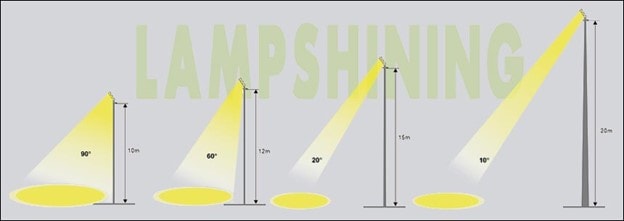
External Conditions Resistance
Because the stadium lights are situated outside, they must withstand adverse weather conditions such as wind and rain. Therefore, the functioning system of the lights will be affected if they are not resistant to the outdoor climate, as humidity or water might destroy them.
Put these elements into consideration and chose IP65 or higher rating so that your LED football field lights can continue to perform at total capacity in the future, whether it’s windy or pouring excessively. Corrosion and dust-proof are must-to-have features.
Lighting fixtures arrangement
The quantity and layout of lighting poles depend on the field area, spectators, and preference. You can arrange them in 4, 6, or 8 layout setups. For spacious areas, poles can be paced between bleachers. The four and six light setups are most commonly used. The following table shows the IES standards for lighting levels.
College football Field | 100-150 fc |
High school Field (5000 spectators) | 50 fc |
High school Field (2000 Spectators) | 30 fc |
Recreational | 20 fc |
For creating homogeneous lighting, the max/min fc in the area is calculated. For college fields, the ratio should be 2.0 or below. For high school and smaller fields, the ratio should be 2.5. This ensures no dark or shadowy spots are left on the ground.
Broadcast Television
What good is it to spend a lot of money on lighting if it won’t show up on TV? The football field lighting should be top-notch in the growing era of 4K and HD broadcasting if you want your viewers at home to enjoy the event as much as the spectators in the stadium.
The Lighting’s Glare and Flicker
Although glare is rarely considered, it is an essential factor in football field illumination. High glare values cause visual discomfort, making it difficult for players to maintain track of the fast-moving ball. Anti-glare characteristics reduce flicker and result in smooth broadcasting.
The Average Cost Of LED Football Field Lights
Let’s take an example of a high school football field that requires 300-400 lux. LED lamps will consume 35000 watts to produce this illuminance, whereas metal halides will suck 70000 watts of power for similar brightness.
In the US, the electricity cost is 12 cents per kWh. So the cost per hour can be calculated as 35000 x 0.12/1000= $4.2, which amounts to $378 for LEDs.
The cost for metal halides with the same lux would be $756, excluding the maintenance cost. So now you can decide which lamp is best for your stadium lights.
Conclusion
We hope the information in this post will help you choose the best football field lights for your stadium to ace your game. Low glare, steady illumination, lenses, fixture, and precise pole are all factors that influence the lights’ performance. Ordinary floodlights can not be used, as football field lights require a specific angle of light, stability, anti-glare devices, and cut-off angle requirements.
If your LED football field lights check all of these criteria, they’re ready to shine like never before in your arena, and we provide you with the best of the lot.
